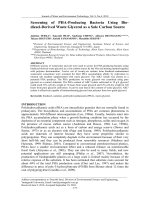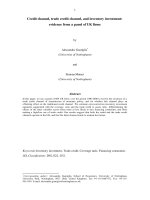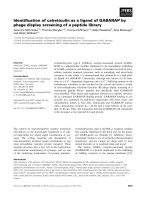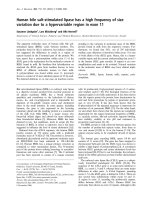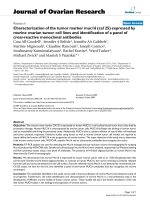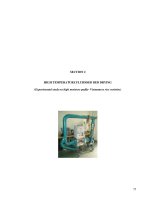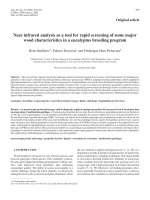Screening of salt tolerance potential of a panel of Vietnamese rice landraces at seedling stage
Bạn đang xem bản rút gọn của tài liệu. Xem và tải ngay bản đầy đủ của tài liệu tại đây (210.32 KB, 6 trang )
Journal of Vietnam Agricultural Science and Technology - No.1(3)/2018
should be made to enhance breeding for salt tolerant
rice adapting on saltwater intrusion conditions.
Farmers should be trained on appropriate soil and
water management measures, testing salinity and
using salt tolerant rice varieties.
Further experiments need to be implemented for
more crop seasons to identify scienti c results for
encouragement of applying advanced technology
such as new rice varieties and cultivation technique
in similar ecological regions in the Red River Delta.
In addition, it is important to improve the irrigation
infrastructure to increase the availability of fresh
water for ushing out salts. Under low rainfall
periods, fresh water use for irrigation is limited and
hence, it is a constraint.
REFERENCES
Dasgupta S, Laplante B, Meisner C, Wheeler D, Yan J,
2007. e Impact of Sea Level Rise on Developing
Countries: A Comparative Analysis. World Bank
Policy Research Working Paper No. 4136.
Dasgupta S, Laplante B, Murray S, Wheeler D., 2010.
Exposure of developing countries to sea-level rise
and storm surges. Climatic Change. DOI 10.1007/
s10584-010-9959-6.
MONRE, 2012. Vietnam climate change and seas
level rise. Natural Resources and Environment
publishing house. Ministry of Natural Resources and
Environment.
Hanh, P.T.T. and Furukawa, M., 2007. Impact of sea
level rise on coastal zone of Vietnam. Bulletin-college
of Science University of the Ryukyus, 84, pp.45.
Vien, T.D., 2011. Climate change and its impact
on agriculture in Vietnam. Hanoi University of
Agriculture, J. Issaas, 17(1), pp.17-21.
Zeidler, R.B., 1997. Continental shorelines: climate
change and integrated coastal management. Ocean
coastal management, 37(1), pp.41-62.
Date received: 8/9/2018
Date reviewed: 25/9/2018
Reviewer: Assoc. Dr. Tran Danh Suu
Date approved for publication: 25/10/2018
SCREENING OF SALT TOLERANCE POTENTIAL OF A PANEL
OF VIETNAMESE RICE LANDRACES AT SEEDLING STAGE
Nguyen
Hoang i Giang*1, Floran Gathignol2, Le Trong Duc1,
anh Tuan3, Gantet Pascal 4,5, Pham Xuan Hoi1, Lebrun Michel4,6
Abstract
In the present study, thirty three Vietnamese rice landraces at seedling stage were evaluated for their salt tolerance
at ve salinity levels of 0 mM, 100 mM, 150 mM, 200 mM, and 250 mM NaCl. Plants were grown in hydroponics
with salt application at the fourth leaf stage. Salt tolerance score, survival rate and dry weights of shoot and root
were measured at 7 and 14 days of stress. e results showed that increasing salinity level from 0 to 250 mM caused
an obvious decrease in seedling growth of all tested Vietnamese rice landraces. At 7 days of stress, most genotypes
exhibited a salt tolerance ranging from tolerant to moderately tolerant with increasing salinity. A er 14 days, salt
stress caused deleterious e ect on almost all genotypes, especially at 200 and 250 mM, where no salt tolerant genotype
were observed. At 100 mM NaCl treatment for 14 days, the lines Pokkali, G138 were noted to be the most tolerant
and twenty other genotypes were ranked as moderately tolerant. At 150 mM, G138 and G45 were evaluated to be
moderately tolerant as Pokkali, whereas the others were more susceptible, but less than IR29.
Keywords: Salinity, salt tolerance, landrace, growth
INTRODUCTION
Rice (Oryza sativa L.) is one of the most important
crops as it is a staple for over 3 billion people in the
world, especially in the Asia-Paci c region. With
the continuous increase of the population, global
food production has to double by 2050 to meet
Agricultural Genetics Institute, National Key Laboratory for Plant Cell Biotechnology, LMI RICE-2, Hanoi, Vietnam
IRD, Université de Montpellier, LMI RICE-2, Hanoi, Vietnam
3
VNUA, Faculty of Agronomy, Department of Genetics and Plant Breeding
4
University of Science and Technology of Hanoi, LMI RICE-2, Hanoi, Vietnam
5
Université de Montpellier, IRD, UMR DIADE, 34095 Montpellier, France
6
Université de Montpellier, IRD, UMR LSTM, 34095 Montpellier, France
*
Corresponding author: Hoang i Giang. Email:
1
2
27
Vietnam Academy of Agricultural Sciences (VAAS)
the demand (Tilman et al., 2011). For rice, yield is
increasing at 1.0% per year which is less than 2.4%
per year rate needed to achieve the goal by 2050
(Ray et al., 2013). As the h biggest rice producer
in the world (FAO, 2017), Vietnam has been coping
with salinity intrusion in the coastal areas of Mekong
delta caused by the climate change to maintain its
rice production level. Actually, Vietnam is one of the
ve countries most a ected by climate change (IPCC,
2007). Sea level is expected to rise between 49 to 95
cm at the end of the 21st century causing salinization
of both Mekong delta and Red River delta, major
rice cultivated areas. In parallel, the increase of
temperatures up to 3.70C will make salinization of
inland soils get worse (Schmidt- omé et al., 2015).
e precise e ect of salinity in rice is determined by
a complex interaction of several factors including the
severity, timing and duration of the stress (Zeng et al.,
2001). Rice salt sensitivity changes during the lifetime
but most severe e ects are observed during seedlings
and reproductive stage. At seedling stage, salts
accumulated in older leaves may cause premature
senescence and slow growth of new produced leaves
( itisaksakul et al., 2015). Salt concentrations
above the tolerable threshold would compromise the
adaptive processes and lead to the death of the plant.
Vietnam is one of the centers of diversi cation
of cultivated rice in Asia.
anks to a multitude
of environmental conditions in terms of climate,
landscapes and irrigation practices, many rice
genotypes can be found.
is valuable genetic
resource can be the basis of rice improvement in
order to produce new high salt-tolerant varieties
with high yield by breeding program. e aim of this
study is to identify among a panel of 33 Vietnamese
rice landraces which ones show the best salt tolerance
under a range of NaCl concentration.
MATERIALS AND METHODS
Plant materials
Among a panel of 182 Vietnamese rice landraces
screened under a moderate salt stress (100 mM NaCl)
in a previous study, 33 genotypes showing best results
in term of salt tolerance were used as materials for
this study (Table 1). e criteria used to select these
genotypes are salt tolerance score, leaf water content,
Na+ and K+ ion content and Na+/K+ ratio in leaves.
is panel came from diverse locations throughout
Vietnam.
e characteristics of the full panel can
be found in Phung et al. (2014). Additionally, IR29
(salt-sensitive) and Pokkali (salt-tolerant) were used
as standards.
Table 1. List of 33 Vietnamese rice landraces used in phenotyping experiment
ID
Name
Province
Ecosyst.
ID
Name
G10
G105
G106
G107
Tam Son Nam Dinh
Nep ai Lan
Nep Hai Hau
Nep ai Binh Lun
Nam Dinh
Ha Giang
Ninh Binh
Ninh Binh
UP
UP
IR
IR
G20
G22
G24
G39
Te Le Hoa Binh
Trung Trang Tuyen Quang
Tam Xoan Hai Hau
Nep Cam
Hoa Binh
na
Nam Dinh
Ha Giang
UP
UP
UP
RL
G108
G113
G130
G133
G134
G138
G14
G154
G155
Tam Ap Be
Nang iet
Lua Da Bo
A 330
Padai Caloc
Nang Quat
Tam Nho Bac Ninh
Nep om
Khau Pe Lanh
Nep Van Ruong
Hoa Binh
Giong 90 Ngay
Nep Quyt Hai Duong
On
Ninh Binh
Vung Tau
Khanh Hoa
Khanh Hoa
Khanh Hoa
Ben Tre
Bac Ninh
Ha Tay
Son La
IR
IR
UP
IR
UP
RL
na
IR
UP
G45
G46
G48
G50
G64
G68
G8
G83
G84
Nep Cuc
Nep Ba Lao
Lua Ngoi
Lua Nep Ba ang Dang 1
Ven Do
Nep 3 ang
Chon Tu 502 Hoc Vien
Nep Vang
Ba Cho Kte
Ninh Binh
Nam Dinh
Nam Dinh
Quang Nam
Quang Tri
Binh Dinh
na
Quang Ngai
Binh Dinh
RL
MG
MG
UP
IR
IR
UP
UP
UP
Hoa Binh
na
G85 Chanh Chui
Kien Giang
Hai Duong
na
RL
UP
na
G98 Ngoi Tia
G99 Lua Cham Bien
G16
G165
G18
G19
Notes: na - no data available; UP - upland; RL - rainfed lowland; MG - mangrove.
28
Province
Ecosyst.
anh Hoa
MG
Nam Dinh
Ninh Binh
RL
RL
Journal of Vietnam Agricultural Science and Technology - No.1(3)/2018
Phenotyping experiment
RESULTS AND DISCUSSION
e genotypes were grown in hydroponics following
the IRRI standard protocol (Gregorio et al., 1997)
with 5 di erent concentrations of NaCl (0 mM
(control), 100 mM, 150 mM, 200 mM and 250 mM)
and three replicates. In each replicate, the genotypes
were randomly distributed in one styrofoam oat of
35 holes (2 mm diameter) in an individual plastic tray
(36 ˟ 31 ˟ 15 cm) lled with Peters solution (20/20/20
NPK, pH 5.1).
Evaluation of salt tolerance by survival rate and salt
tolerance score
e experiment was set under net house conditions.
Seeds were germinated on water during 5 days at
280C, then seedlings were cultured in the styrofoam
oats with nylon net bottom. Each genotype was
grown in one hole (plot) with four seedlings. Water
level and pH were adjusted daily.
e nutrient
solution was renewed once every week untill the end
of experiment. Salt stress was applied when seedlings
reached the fourth leave stage. Salt NaCl was
supplemented to the hydroponic medium gradually,
each time 50 mM NaCl, separated by two days to get
the higher nal concentration of 250 mM NaCl. e
EC (electrical conductivity) value of all experimental
trays was maintained by adding water or salt daily.
e experiment was stopped at 14 days a er the
initial salt treatment.
Plants were monitored carefully each day a er the
start of salt treatment to visualize any salt stress
symptoms and side e ects. A er 7 days and 14 days,
the survival rate was determined by counting the
number of dead/alive plants in each plot. At 7 and 14
days of stress, salt tolerance score was assessed based
on leaf injury symptoms using the modi ed standard
evaluation system (salt tolerance) for rice (Gregorio
et al., 1997), as follows: score 1 (highly tolerant) normal growth, no leaf symptoms; score 3 (tolerant) near normal growth, but leaf tips or few leaves whitish
and rolled; score 5 (moderate tolerant) - growth
severely retarded, most leaves rolled, only a few are
elongating; score 7 (susceptible) - complete cessation
of growth, most leaves dry, some plants dying; score 9
(highly susceptible) - almost all plants dead or dying.
A er two weeks of salt stress treatment, collect aerial
part and root system separately for each plot, then
oven-dry the samples at 700C for 3 days and weigh to
obtain the dry weight of root and shoot.
Time and place of the study
e experiment was conducted in the Agriculture
Genetics Institute (AGI) - Hanoi, Vietnam, in August
- September 2017.
To assess the response of genotypes to di erent
salinity levels, we recorded capacity for survival over
time: a er 7 and 14 days of salt stress treatment. e
results presented in Figure 1A showed that a er 7
days of stress most genotypes reached on average
the survival rate of 100% at 100 mM NaCl, with the
exception of G14 and G50 for which values of 91.8%.
According to the assessment of salt tolerance score,
genotypes were classi ed into three groups: highly
tolerant (G19, G108, G138 and Pokkali), tolerant
(17 genotypes), and moderately tolerant (14 genotypes,
including IR29) (Figure 1B).
With increasing salinity survival rate and salt tolerance
of some genotypes tended to decrease a er 7 days of
stress. e decrease of survival rate was observed in 2
genotypes at 150 mM, 4 ones at 200 mM and 9 ones
at 250 mM (Figure 1A). e salt tolerance score of
genotypes ranged from 0 to 5.67 at 100 mM, from 1.0
to 6.33 at 150 mM, from 1.0 to 7.0 at 200 mM, and
3.67 to 7.0 at 250 mM. Among 35 genotypes, G19 and
Pokkali exhibited the highest degrees of salt tolerance
in all four tested salinity levels, whereas IR29 was the
most susceptible to salinity, exhibiting the highest
salt tolerance score in each treatment (i.e. score 7 at
200 mM and 250 mM) (Figure 1B). By analyzing
the salt tolerance scores, a large range of number of
genotypes among tolerance levels was observed, with
highly tolerant group varying from 4 genotypes at
100 mM to 0 genotypes at 250 mM, tolerant group
declining from 17 to 3, moderately tolerant group
rising from 14 to 29 genotypes (Figure 1B). IR29 was
always most sensitive to salt stress.
A er 14 days of salt stress, deleterious e ect of salt
stress was clearly observed in all rice landraces
and standards. Both parameters of salt tolerance
signi cantly declined with rising the level of salinity
(Figure 2). Salt sensitive standard IR29 died in
all tested levels of salinity with the salt tolerance
score of 9.0. e survival rate among rice landraces
ranged from 50% to 100% at 100 mM, from 0% to
91.7% at 150 mM, from 0% to 66.7% at 200 mM, and
from 0% to 50% at 250 mM. Genotypes were also
grouped according to their tolerance level. At 100
mM stress, G138 and Pokkali remained tolerant, 20
other genotypes were determined to be moderately
tolerant (i.e. G10, G106, G107, G108, G130, G154,
G165, G19, G20, G39, G45, G46, G48, G64, G68, G8,
G84, G85, G98, G99). At 150 mM, we found only
29
Vietnam Academy of Agricultural Sciences (VAAS)
two moderately tolerant genotypes (G45 and G138)
which were equally tolerant as Pokkali. At 200 mM
and 250 mM NaCl, visual damage was serious, leaf
drying and seedling dead were observed on all plots,
including Pokkali. Interestingly, G138 was ranked at
the top as Pokkali for its salt tolerance in all tested
salinity levels.
Figure 1. Survival rate (A) and salt tolerance score (B) of rice genotypes at 7 days in di erent levels of salinity
Figure 2. Survival rate (A) and salt tolerance score (B) of rice genotypes at 14 days in di erent levels of salinity
30
Journal of Vietnam Agricultural Science and Technology - No.1(3)/2018
Growth characteristics
A er 14 days, salt stress caused a decrease in seedling
shoot and root growth in most of the genotypes
(Figure 3), except for G84, which dry weights of shoot
and root were larger than control condition 0 mM,
perhaps due to the experimental error. e reduction
was more at higher salinity levels, and almost
equivalent at 200 mM and 250 mM. A dramatic
decrease in shoot dry weight and root dry weight
(above 50% under all stress treatments compared
with no salinity) was observed for G10, G14, G18,
G50, G98 and IR29. Among genotypes the lowest
drop in shoot dry weight (13.4 - 25.9%) and root dry
weight (0 - 20.3%) was recorded for G48, indicating
its tolerance to salinity. Likewise, the decline of salt
tolerant Pokkali was18 - 48.2% in shoot dry weight
and 0 - 38.0% in root dry weight. e genotype G138
assessed for best salt tolerance among rice landraces,
exhibited a decrease 0.1 - 55.7% and 15.9 - 47.7% in
shoot and root dry weight, respectively. Similar results
were reported by Tatar et al. (2010), who observed a
signi cant reduction in the total dry matter of rice
cultivars at the seedling stage.
Generally, the seedling biomass growth appeared
not strongly correlated with salt tolerance among
genotypes. However, these morphological parameters
demonstrated the ability to maintain growth of
genotypes under salt stress. e signi cant reduction
in shoot dry weight, root dry weight as well as other
growth parameters such as root length, plant height,
root number per plant are considered as indicators
of rice plant response to salt stress (Jamil et al., 2006;
Chunthaburee et al., 2016; Hussain et al., 2017).
Figure 3. Shoot dry weight (A) and root dry weight (B) of rice genotypes at 14 days in di erent salinity levels
CONCLUSIONS
Large di erences between rice genotypes in response
to salt stress were observed.
e salt tolerance
and seedling growth of genotypes decreased with
increasing salinity levels. Signi cant reduction was
observed for most genotypes at 14 days of stress in
all tested salinity levels, in particular, deleterious
effect was reported at the higher salinity levels.
e Vietnamese rice landraces were ranked with
G138 as the most tolerant, equivalent Pokkali in terms
of salt tolerance and seedling growth. Moderately
tolerant level was noted for twenty other landraces at
100 mM, and for G45 at 150 mM. is study revealed
that the Vietnamese rice diversity has the potential
to be used for increasing salt tolerance and improve
adaptation to salt stress.
31
Vietnam Academy of Agricultural Sciences (VAAS)
REFERENCES
Chunthaburee S., Dongsansuk A., Sanitchon J.,
Pattanagul W., eerakulpisut P., 2016. Physiological
and biochemical parameters for evaluation and
clustering of rice cultivars di ering in salt tolerance
at seedling stage. Saudi Journal of Biological Sciences
(2016), 23, 467-477.
FAO, 2017. Crop prospects and food situation report.
Food and Agriculture Organisation of the United
Nations, 2.
Gregorio G.B., Gharmawansa S. and Mendoza R.D.,
1997. Screening rice for salinity tolerance. IRRI
discussion paper Series N0.22. International Rice
Research Institute. Manilla, Philippines. pp.2-23.
Hussain S., Zhang J., Zhong C., Zhu L., Cao X., Yu S.,
Allen B.J., Hu J., Jin Q., 2017. E ects of salt stress
on rice growth, development characteristics, and
the regulating ways: A review. Journal of Integrative
Agriculture, 16 (11): 2357-2374.
IPCC, 2007. Fourth assessment report (AR4): climate
change 2007. Contribution of working groups I,
II and III to the fourth assessment report of the
intergovernmental panel on climate change (IPCC),
Cambridge University Press, Cambridge.
Jamil M., Bae L.D., Yong J.K., Ashraf M.,Chun L.S.,
Shik R.E., 2006. E ect of salt (NaCl) stress on
germination and early seedling growth of four
vegetables species. Journal of Central European
Agriculture, 7: 273-282.
Phung T.P.N., C.D. Mai, P. Mournet, J. Frouin, G. Droc,
N.K. Ta, S. Jouannic, L.T. Le, V.N. Do, P. Gantet
and B. Courtois, 2014. Characterization of a panel
of Vietnamese rice varieties using DArT and SNP
markers for association mapping purposes. BMC
Plant Biology, 14: 371.
Ray D.K., Mueller N.D., West P.C., Foley J.A., 2013.
Yield trends are insu cient to double global crop
production by 2050. PLoS ONE 8, e66428.
Schmidt- omé P., Nguyen H., Pham L., Jarva,J.,
Nuottmäki K., 2015. Climate change adaptation
measures in Vietnam. SpringerBriefs in Earth Sciences.
Tatar O., Brueck H., Gevrek M.N., Asch F., 2010.
Physiological responses of two Turkish rice (Oryza
sativa L.) varieties to salinity. Turk. J. Agric. For., 34:
451-459.
itisaksakul M., Tananuwong K., Shoemaker
C.F., Chun A., Tanadul O.U.M., Labavitch J.M.,
Beckles D.M., 2015. E ects of timing and severity
of salinity stress on rice (Oryza sativa L.) yield, grain
composition, and starch functionality. Journal of
Agricultural and Food Chemistry, 63 (8).
Tilman D., Balzer C., Hill J., Befort B.L., 2011. Global
food demand and the sustainable intensi cation of
agriculture. Proc Natl Acad Sci USA 108: 20260-20264.
Zeng L., Shannon M.C., Lesch S.M., 2001. Timing
of salinity stress a ects rice growth and yield
components. Agric. Water Manage., 48: 191-206.
Date received: 21/9/2018
Date reviewed: 28/9/2018
Reviewer: Assoc. Dr. Dang Minh Tam
Date approved for publication: 25/10/2018
OVEREXPRESSION OF GMCHS7 IN SOYBEAN LEADS TO
REDUCED PIGMENTATION IN HILUM OF TRANSGENIC SEEDS
Nguyen Anh Vu*1, Pham Xuan Hoi1, Do i Nhu Quynh1,
Nguyen Trung Anh1, Nguyen Huu Kien1, Le Huy Ham1, Nguyen Van Dong1
Abstract
GmCHS7 gen was cloned and transferred to DT22 soybean plants by agrobacterial vector. Transgenic plants were
selected based on their resistance to ammonium glufosinate conferred by the bar gene which is co-expressed in the
T-DNA. e presence of transgene in surviving plants were further con rmed by using PCR. Transgenic plants
showed no morphological di erence from DT22 variety except for hilum color which ranges from white to brown in
the seeds of transgenic plants compared to black or imperfect black in that of DT22 plants. e results showed that
overexpression of GmCHS7 gene lead to a decreased in pigmentation of the hilum in the seeds of soybean plants.
Keywords: Anthocyanin deposition, GmCHS7, hilum, overexpression, reduction, soybean, transgenic
INTRODUCTION
Soybean [Glycine max (L.) Merr.], native to East
Asia, is the most widely grown grain legume in the
world. Its seeds are widely used as the major sources
1
*
of vegetable oils and plant protein (Hartman et al.,
2011). e plant grows annually with erected, bushy
stem, reaching the height of 50 - 120 cm when fully
mature. Soybean seeds contain eight essential amino
Agricultural Genetics Institute
Corresponding author: Nguyen Anh Vu. Email:
32
